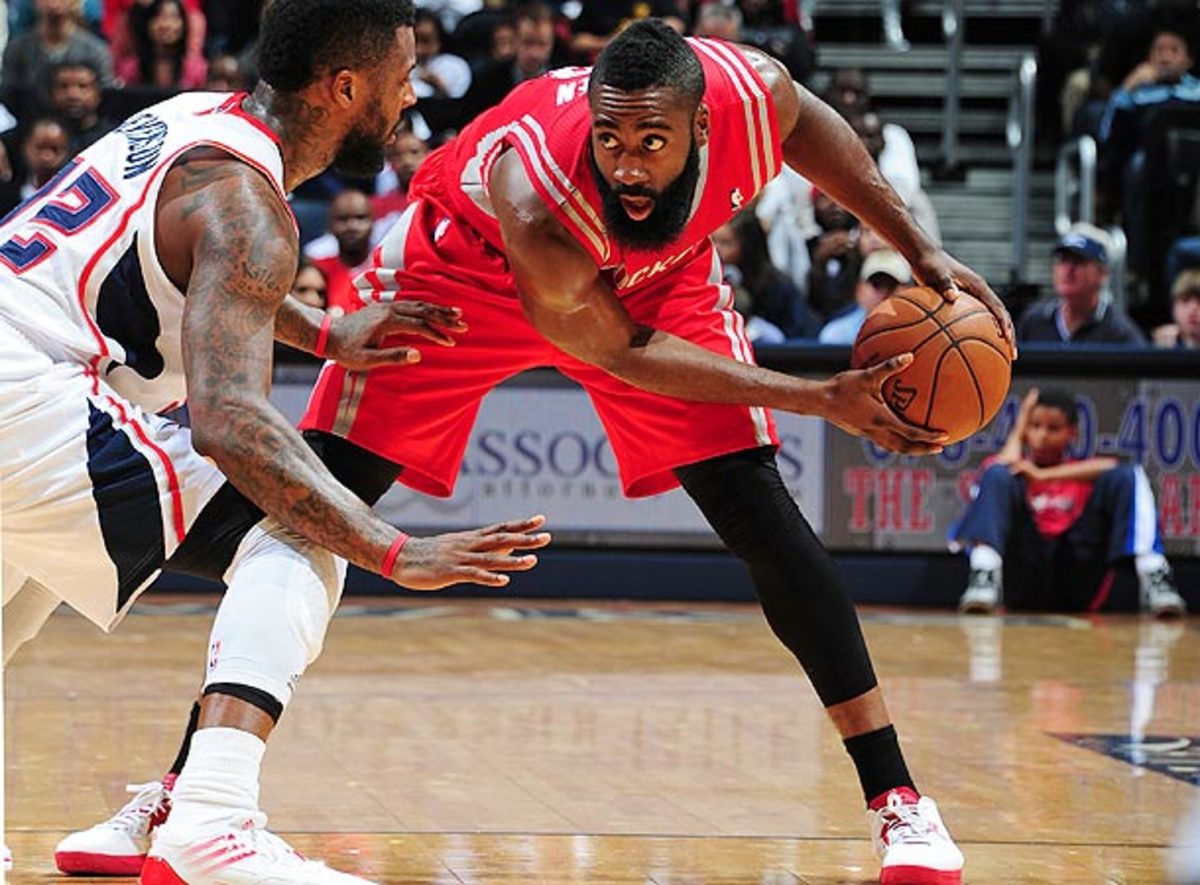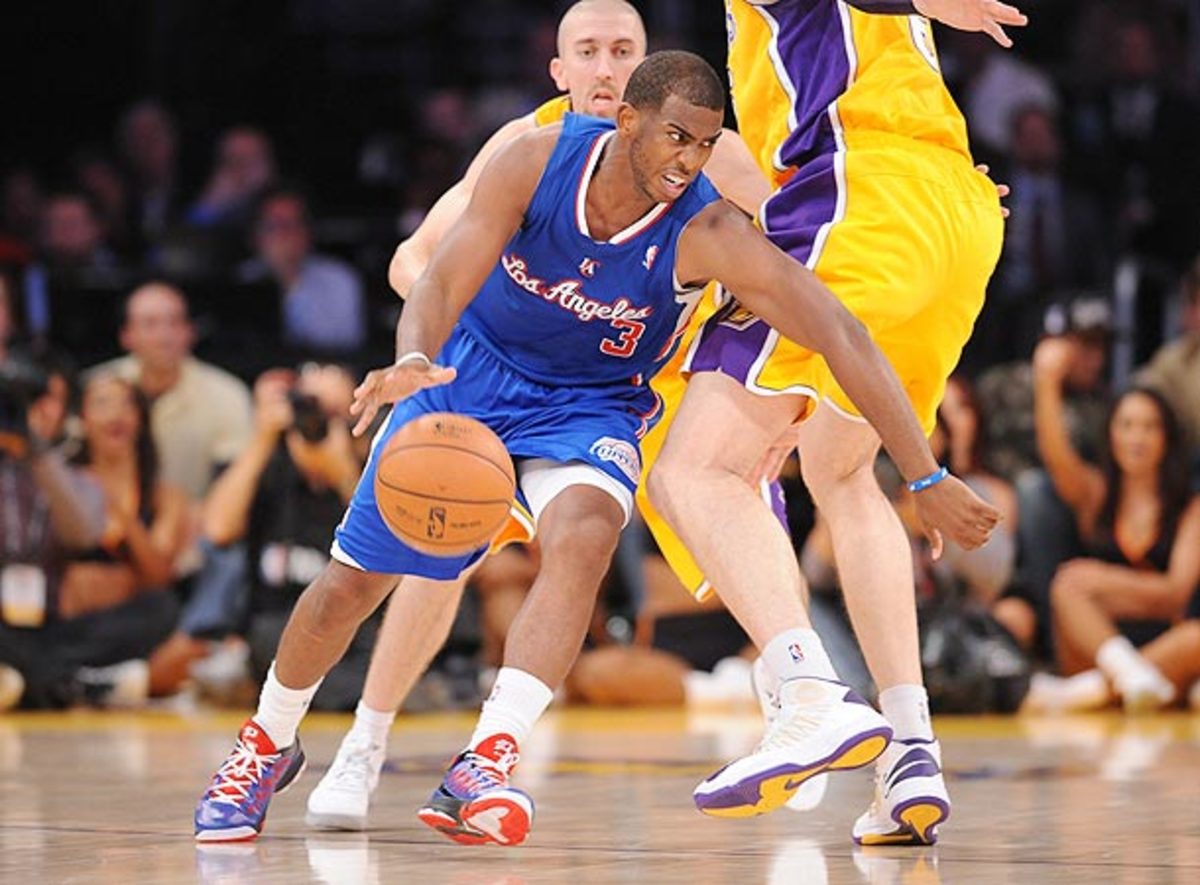Fact or fiction: Taking a side on early-season developments in the West

James Harden is the NBA's leading scorer, averaging 35.5 points per game. (Scott Cunningham/NBAE via Getty Images)

By Ben Golliver
The 2012-13 NBA season is almost a week old now, and there's a "down is up, up is down" feel to it. The Magic sit atop the Southeast Division; the Nuggets are in the Northwest Division cellar. The Knicks are undefeated; before Sunday's defeat of the awful Pistons, the Lakers were in sole possession of the league's worst record. What's stood out in Week 1? And, more importantly, which early season developments will stick going forward? Let's take a look.
Fact: James Harden is heading for a staggering offensive season
The personal exchange facing James Harden after his trade from the Thunder to the Rockets was simple: short-term title contention swapped for cash, minutes, shots and the increased profile that comes with that combination. He wasted no time in making the most of his new benefits: Harden had 37 points, 12 assists, six rebounds and four steals in his Rockets debut, followed that with 45 points and seven rebounds on Friday against the Hawks and then, on an off night, he tallied 24 points, six rebounds and five assists against the Blazers on Saturday. Through three games, Harden is the NBA's leading scorer, averaging 35.5 points, six points more than his nearest competition, and he was named the Western Conference player of the week Monday afternoon.
Most of the attention was given to Harden's first two performances, as both produced wins and ungodly stat lines. His play in the Rockets' overtime loss to the Blazers was just as instructive. See, Harden was not at his best. He missed five shots in the paint, getting unfriendly rolls on multiple occasions. He had five turnovers, including one on a key play in which Blazers guard Wesley Matthews ripped the ball clean out of his hands, ending a potential game-winning possession at the end of regulation. In past years, the loaded Thunder offense would have marched on without Harden, the third option, if he wasn't hitting.
In Houston, the Rockets have no choice. Good, bad or ugly, Harden is the guy, getting 24 shot attempts even when he's only hitting one out of every three. Six of the Rockets' top seven shot-takers from 2011-12 (Kevin Martin, traded to the Thunder; Luis Scola, released under the amnesty clause; Kyle Lowry, traded to the Raptors; Goran Dragic, signed with the Suns as a free agent; Courtney Lee, sign-and-traded to the Celtics; and Chase Budinger, traded to the Timberwolves) are gone. Only Chandler Parsons (8.7 attempts per game last season) remains. What's more, none of the replacements, aside from Harden and scoring point guard Jeremy Lin, are proven offensive options. Excepting Harden and Lin, the other seven members of coach Kevin McHale's current rotation (Parsons, Patrick Patterson, Omer Asik, Marcus Morris, Carlos Delfino, Toney Douglas and Cole Aldrich) averaged a combined 39.9 shots per game last season. By comparison, Kevin Durant and Russell Westbrook combined to average 38.9 shots per game by themselves while Harden averaged just 10.1 shots last season. This is a lay-up for McHale: He's got Harden, itching for more, and no one else, save Lin, mounting any real challenge for the rock. The solution? Feed the beard.
Harden's transition to No. 1 option winds up serving as a good example of why extrapolating per-minute numbers to actual performance requires a careful eye toward context. His per-36 minute numbers in Oklahoma City -- 19.3 points, 4.7 rebounds, 4.2 assists, 1.1 steals -- were very good. They weren't, however, necessarily indicative of All-NBA caliber scoring if his role increased, because Durant and Westbrook loomed as such limiting factors. The Rockets' current set up -- a green light for Harden, few other reliable scoring options -- bakes in a production floor for Harden. By virtue of a Texas-sized opportunity (Harden is currently averaging 22.7 field-goal attempts per game, good for No. 4 in the league) and a proven ability to get to the free-throw line (Harden is averaging 11 free-throw attempts per game, good for No. 4 in the league), Harden can be counted on for 20+ points a night, almost regardless of how well he plays. He was a top-five player at his position in terms of overall offensive efficiency last season and he's a career 37 percent three-point shooter, so there's plenty of reason to believe that he can keep his scoring average closer to 30 than 20 now that he's fully unshackled. That would put him square in the middle of the scoring champ race; Durant and the Heat's LeBron James, perennial contenders for the award, should emerge as the other favorites, but both have high-usage teammates who have helped cap them out around 28 points per game over the last two seasons.
All things considered, picking Harden to wind up as the league's top scorer is more sane than insane.
Chris Paul and the Clippers have impressed with wins over the Lakers and Grizzlies. (Noah Graham/NBAE via Getty Images)

*****
Fiction: The Clippers are legit title contenders
The Clippers look like world-beaters after opening with impressive wins against the Grizzlies and the Lakers. Their nationally-televised dissection of their crosstown rivals really stood out, as the Clippers looked younger, deeper and more athletic than the Lakers, and they succeeded in holding Dwight Howard in check and forcing Kobe Bryant into his one-man scoring routine. Chris Paul held the game firmly in his grasp, finishing with 18 points, 15 assists and six rebounds, while Jamal Crawford continued a scorching early-season run, single-handedly outscoring the Lakers bench 21-17. Talk of championship contention is inevitable any time a star-laden team trounces a supposed conference favorite like that. That buzz only gained credence with the Thunder's slow start. Who doesn't like the idea of a wide-open race?
There are a few good reasons to pump the brakes. First, there's Crawford, who is shooting a jaw-dropping 53.5 percent from the field and 47.3 percent from deep and providing plenty of YouTube fodder with his dribbling skills. Crawford currently ranks fifth in the NBA with 25.7 points per game and is one of only three reserves in the top 20. All of this is comically unsustainable. Last season, no reserves finished in the top 25 in scoring; James Harden was tops among reserves in scoring, with 16.8 points per game, significantly below Crawford's strong start. Long known as a streaky shooter, Crawford has topped 42.1 percent shooting just once in the last 10 seasons. Also, his shot-attempt total is sure to take a hit when Chauncey Billups returns from injury, and Vinny Del Negro will need to carve some space for Grant Hill, too. There's a fall coming, the only question is how big and how far. (The good news for Crawford is that he has found a far better fit with the Clippers than he had with the Blazers in 2011-12, and he has started so well that he could fall off a cliff and still be in the running for Sixth Man of the Year, an award he won in 2010.)
The Clippers' title hopes don't live and die with Crawford, not by a long shot. The biggest preseason bugaboos -- defense and interior depth -- revealed themselves in Saturday's loss to the Warriors. At home, the Clippers gave up 114 points to a Warriors team playing without starting center Andrew Bogut, who was being rested in the second game of a back-to-back, and without Brandon Rush, who sent the team reeling emotionally when he suffered a season-ending torn ACL on Friday. It wasn't the volume of Golden State's scoring so much as the nature of it; the Warriors, who ranked dead last in rebound rate last season, finished +15 overall on the boards and poured in 48 points in the paint, even with David Lee scoring just eight points on eight shots. Carl Landry put on his hard hat and the Clippers had no response, conceding 23 points and 10 rebounds to the man whose middle name is "undersized."
Perhaps those numbers shouldn't be shocking considering starting center DeAndre Jordan has never been given truly big minutes, and Ryan Hollins, Ronny Turiaf (who didn't play) and Lamar Odom are the only available big-man options off the bench. That brings us to Odom, whose early work is another red flag. The departures of Reggie Evans and Kenyon Martin require a forceful frontcourt bench presence. Hollins, a human telephone pole, has never been the man for that job. So far, Odom, who missed time in the preseason because of a knee injury, looks like some sort of a marshmellow/playdough/down-pillow composite. He's shooting 26.7 percent and averaging 3.0 points and 3.0 rebounds in 15 minutes per game, all down from last year's disastrous season in Dallas. He can get in better shape, but will he? That's not meant as a knock on his character. We're now nearly a year removed from the lockout and four months removed from the trade that brought Odom back to Los Angeles, his preferred reality television mecca. Where are the positive indicators that suggest this will work out?
Caron Butler
